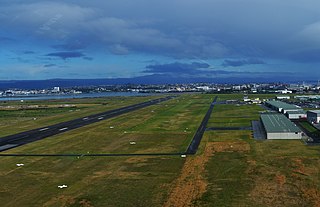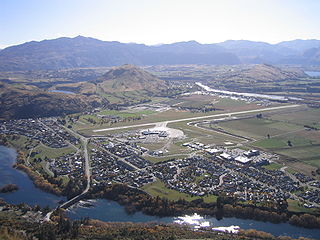
Freedom Air was Air New Zealand Group's low-cost airline which operated since 8 December 1995 to March 2008. It ran scheduled passenger services from New Zealand to Australia and Fiji and charter services within New Zealand. Its main base was Auckland Airport.
New Zealand National Airways Corporation, popularly known as NAC, was the national domestic airline of New Zealand from 1947 until 1978 when it amalgamated with New Zealand's international airline, Air New Zealand. The airline was headquartered in Wellington.
Air Nelson was a regional airline based in Nelson, New Zealand. It was founded as an independent airline in 1979. Air New Zealand took a 50% shareholding in 1988 and 100% ownership in 1995. Air Nelson operated services on provincial routes under the Air New Zealand Link brand.
Air National was an airline based in Auckland, New Zealand. It operated domestic and international charter services and scheduled passenger services for Air New Zealand Link. Its main bases were Auckland International Airport

Eagle Airways was a regional airline based in Hamilton, New Zealand and was wholly owned by Air New Zealand, operating regional services under the Air New Zealand Link brand. The airline was disbanded on 26 August 2016, with staff absorbed into Air New Zealand's other subsidiaries.
Mount Cook Airline was a regional airline based in Christchurch, New Zealand. Formerly part of the Mount Cook Group and latterly a subsidiary of Air New Zealand, it operated scheduled services throughout the country under the Air New Zealand Link brand. In December 2019, the brand name was retired with all services operated under the Air New Zealand banner.

Palmerston North Airport, originally called Milson Aerodrome, is an airport in the Manawatū-Whanganui region of New Zealand, serving Palmerston North City and the Central North Island regions. It is located in the suburb of Milson, on the outskirts of Palmerston North, New Zealand, approximately 5.5 km (3.4ml) NE from the central business district of Palmerston North City. The airport is 100% owned by the Palmerston North City Council and covers an area of 208ha. The airport is New Zealand’s 8th busiest and handled a total of 515,727 passengers in the 2016 financial year. The airport handles around 30 commercial passenger flights per day to and from Auckland, Christchurch, Hamilton, Napier, Nelson and Wellington as well as 2 cargo flights each night between Auckland and Christchurch.

Ansett New Zealand was an airline serving the New Zealand domestic market between 1987 and 2000. It was a subsidiary of Ansett Transport Industries. In order to comply with regulatory requirements relating to the acquisition of Ansett Transit Industries by Air New Zealand, Ansett New Zealand was sold to News Corporation and later to Tasman Pacific Airlines of New Zealand in 2000, operating as a Qantas franchise under the Qantas New Zealand brand. It went into receivership and subsequently liquidation in 2001.

Sounds Air is a New Zealand airline based at Picton. The airline was founded in 1986 by Cliff and Diane Marchant to provide low cost flights to the Marlborough Sounds. The airline has a maintenance facility at the Feilding aerodrome 9 miles northwest of Palmerston North as well as Omaka aerodrome with its Sounds Aero Maintenance division based there.
South Pacific Airlines of New Zealand was a New Zealand airline, operating between 1960 and 1966. It is regarded as a forerunner to Ansett New Zealand.

Tauranga Airport is an airport serving the city of Tauranga, New Zealand. It is located adjacent to Tauranga Harbour in the suburb of Mount Maunganui, approximately 3 km northeast of Tauranga CBD. The terminal is located to the north of the runway, on Jean Batten Drive, and consists of a two-storey building with four tarmac gates. Air New Zealand serves the airport through its subsidiaries Mount Cook Airline and Air Nelson, with flights to Auckland, Wellington and Christchurch. A further two regional airlines also operate to the airport, as well as scenic and charter flights, skydiving operations and general aviation.

Queenstown Airport is located in Frankton, Otago, New Zealand, and serves the resort town of Queenstown. The airport is 8 km (5.0 mi) from the Queenstown CBD. The airport handled 2.25 million passengers as of 2018 making it the fourth busiest airport in New Zealand by passenger traffic. The airport consists of two runways, one of which is paved, and has a single-level terminal building with nine gates.

Vincent Aviation was an airline based in Wellington, New Zealand. It operated air charter, freight and subcontract flights with a hub at Wellington International Airport. It was founded by Peter Vincent in 1992. On 28 May 2014 the Australian business was placed into receivership. On 24 October 2014 the New Zealand division was placed into receivership.

Kapiti Coast Airport, earlier called Paraparaumu Airport, is on the Kapiti Coast of New Zealand's North Island, between the Wellington dormitory suburbs of Paraparaumu Beach, Paraparaumu to the east, and Raumati Beach to the south. The Wharemauku Stream flows through part of the airport's land.
CityJet was a short-lived New Zealand airline. It operated between May and November 1999.

Air Travel (NZ) Limited, a small airline based in Hokitika, was the first airline in New Zealand to fly licensed scheduled air services. They took delivery of their first De Havilland biplane aircraft at the end of 1934 and made it their business to carry passengers, mail and freight to remote parts of the West Coast. Their ambulance services were particularly welcome. They were well known outside their region for taking tourists to the Franz Josef and Fox glaciers.
Mangere Aerodrome, named after a nearby suburb, was the original home of the Auckland Aero Club. It is now the site of Auckland Airport. Mangere Aerodrome's claim to fame was as the arrival point for New Zealand aviator, and aeroclub member, Jean Batten's solo flight from the United Kingdom in 1936. The RNZAF requisitioned the aerodrome from 1939 until 1944, renaming it RNZAF Station Mangere. In 1961, the Auckland Aero Club moved to Ardmore aerodrome and Mangere Aerodrome closed. The new Auckland Airport opened in 1965.

Kiwi Regional Airlines was an airline based in Hamilton, New Zealand which operated domestic flights within New Zealand between October 2015 and July 2016. It was founded in 2014 by local businessman Ewan Wilson, who previously served as the CEO of Kiwi Travel International Airlines, and commenced operations on 27 October 2015. The airline owned and operated a single Saab 340A aircraft. The initial destinations served were Hamilton, Nelson, Dunedin and Queenstown, with flights to Queenstown being dropped in November 2015 and Tauranga being added to the network in February 2016.

The history of aviation in New Zealand began in the late 19th century when balloon flights began. In the first decade of the 20th century, several New Zealanders began developing heavier-than-air craft with the first confirmed powered flight in New Zealand being made by Vivian Walsh in 1911. The First World War spurred the development of aviation in New Zealand. A flying school was established and several hundred New Zealanders went on to serve in British flying services in Europe.
The 1996 New Year Honours in New Zealand were appointments by Elizabeth II in her right as Queen of New Zealand, on the advice of the New Zealand government, to various orders and honours to reward and highlight good works by New Zealanders, and to celebrate the passing of 1995 and the beginning of 1996. They were announced on 30 December 1995.


















